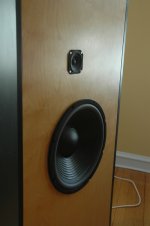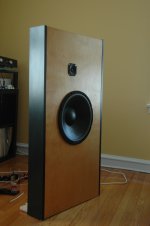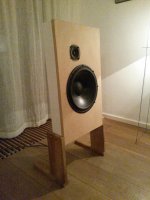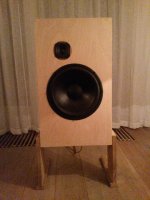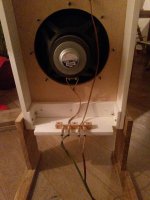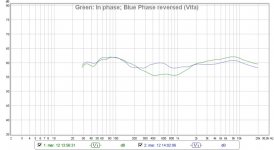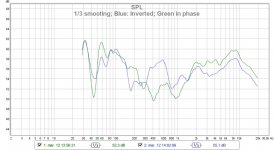My Ultras look very good from about 5 or 10 feet but not from any closer. Such is the quality of my woodworking.
But a few weeks back the sun was hitting them just right and they looked *good*. So the camera came out and some photos were taken.
They don't really look this good in real life but the lighting really highlights their strong points and cleans them up.
No photos of the back of the baffles. They haven't been done yet. 🙄
But a few weeks back the sun was hitting them just right and they looked *good*. So the camera came out and some photos were taken.
They don't really look this good in real life but the lighting really highlights their strong points and cleans them up.
No photos of the back of the baffles. They haven't been done yet. 🙄
Attachments
Hi Uncle_Leon,
I have to admit I paid no attention to the type of glue used for the build. It was simply "wood glue".
At first the Ultras were put together without glue and just a few screws just to see how they sounded. They were good sounding but there were a few oddities that cropped up ... and at least one of the oddities was the very slight air gaps around the Vifa that have been mentioned before.
Other oddities, that I hoped would go away in the final Ultra build, turned out to be electronics issues and not Ultra issues at all. It was just the Ultras let some unresolved electronic issues shine through. Those issues have being addressed and the system continues to get better.
When they finally got put together correctly there was a lot of glue and a lot of screws holding everything together. The baffles are solid and tight. Whatever mistake was made in not using the right glue was (hopefully) addressed by using a lot of it and securing it all with a ton of nails.
I have to admit I paid no attention to the type of glue used for the build. It was simply "wood glue".
At first the Ultras were put together without glue and just a few screws just to see how they sounded. They were good sounding but there were a few oddities that cropped up ... and at least one of the oddities was the very slight air gaps around the Vifa that have been mentioned before.
Other oddities, that I hoped would go away in the final Ultra build, turned out to be electronics issues and not Ultra issues at all. It was just the Ultras let some unresolved electronic issues shine through. Those issues have being addressed and the system continues to get better.
When they finally got put together correctly there was a lot of glue and a lot of screws holding everything together. The baffles are solid and tight. Whatever mistake was made in not using the right glue was (hopefully) addressed by using a lot of it and securing it all with a ton of nails.
You might consider the fact that having loosely fitted drivers initially might have had a different acoustic response. A very leaky edge might make the driver look like it has almost no baffle at all. That can change the FR drastically ! With a well sealed fixture on your broad baffle will bring up the typical peak in the response in the lower midrange/upper bass. That can make the sound completely different.
It might be interesting to measure the response with a calibrated mic. Maybe for this range it needn't be calibrated !
My earliest tests with OB produced 'cuppy' midrange ! I didn't measure it but would have been the peak that is easily seen in simulation also. It was a 3 way.
It might be interesting to measure the response with a calibrated mic. Maybe for this range it needn't be calibrated !
My earliest tests with OB produced 'cuppy' midrange ! I didn't measure it but would have been the peak that is easily seen in simulation also. It was a 3 way.
Ashok, you nailed it. With the tiny air gaps the midrange was brighter sounding and without the gaps the midrange has much more weight and texture.
It's also amazing how profound the midrange changed even though the gaps were really quite small.
It's also amazing how profound the midrange changed even though the gaps were really quite small.
After asking some questions on this forum and thinking about it for a long log time of building a pair of Amzanita's, I've finally bit the bullet! A trip to Ikea provided me some nice kitchen cabinet doors in the correct size😀.
I know the Manzanita's were never intended as floorstanders, but I'm stubborn... The pieces of wood were higher than needed, so I figured it should compensate for some of the influence by the floor etc. Next to that, the Vifa's were a little too low for ear level, so I inclined the panels a bit.
I only just have the proto's finished, but already I'm so heavily impressed that I just wanted to share it with you all!
First some pictures (bit crappy, taken in the dark with my old Iphone):
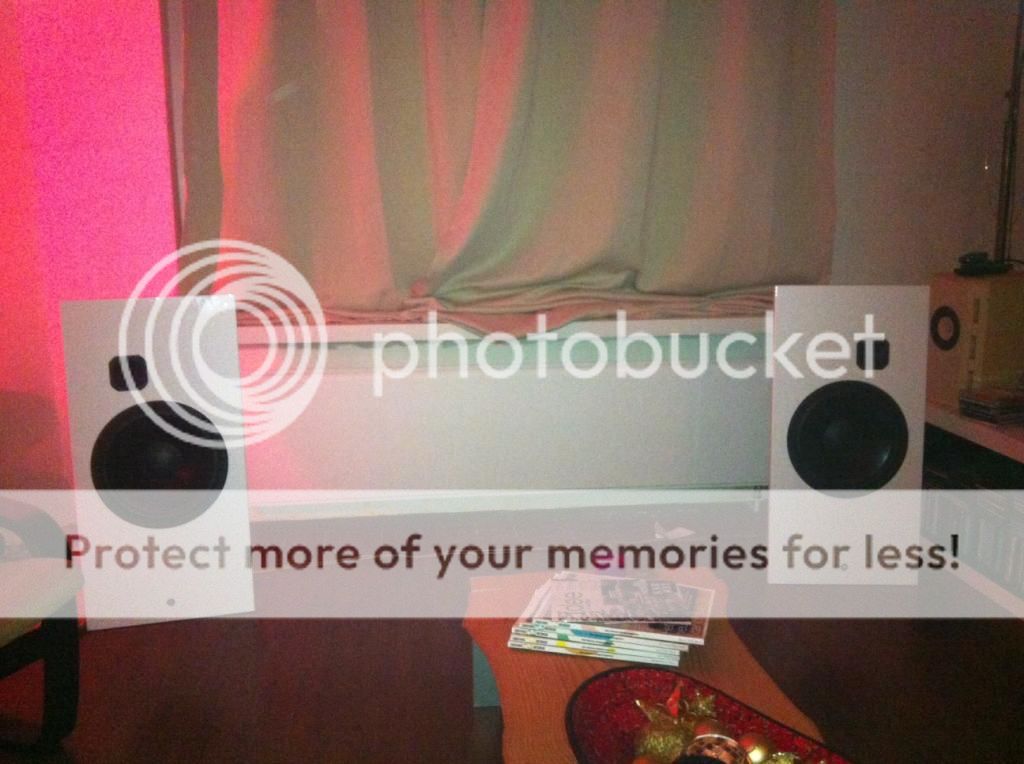
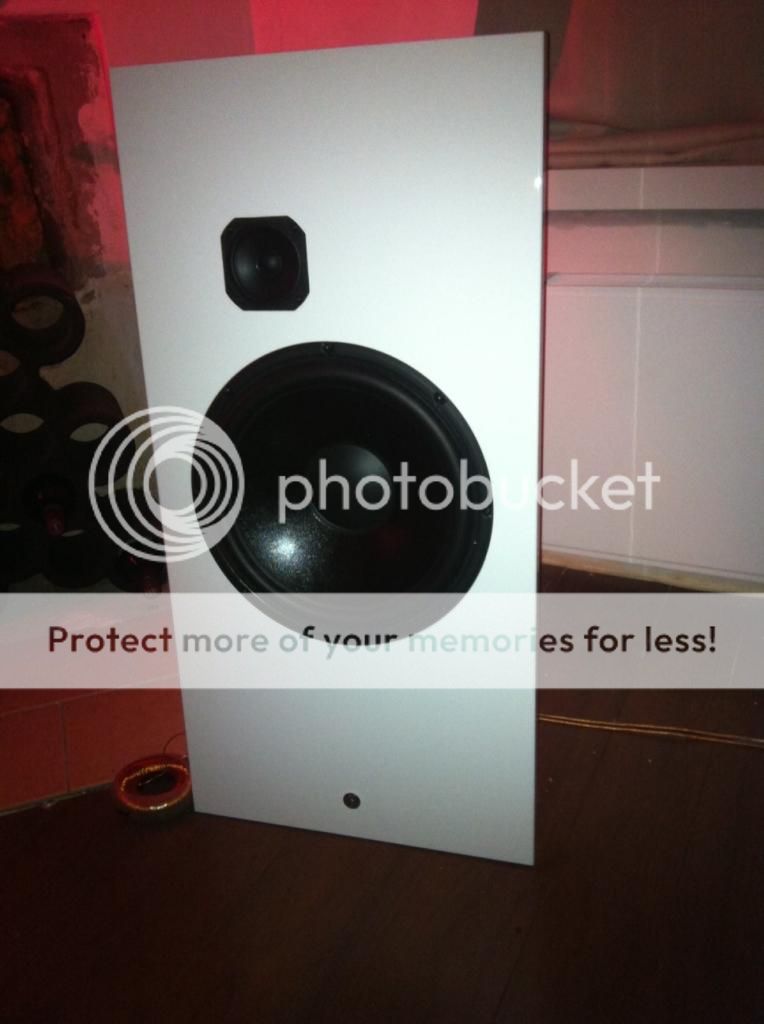
I thought the filters might need to be tweaked quite some bit, so made a very temporary one:
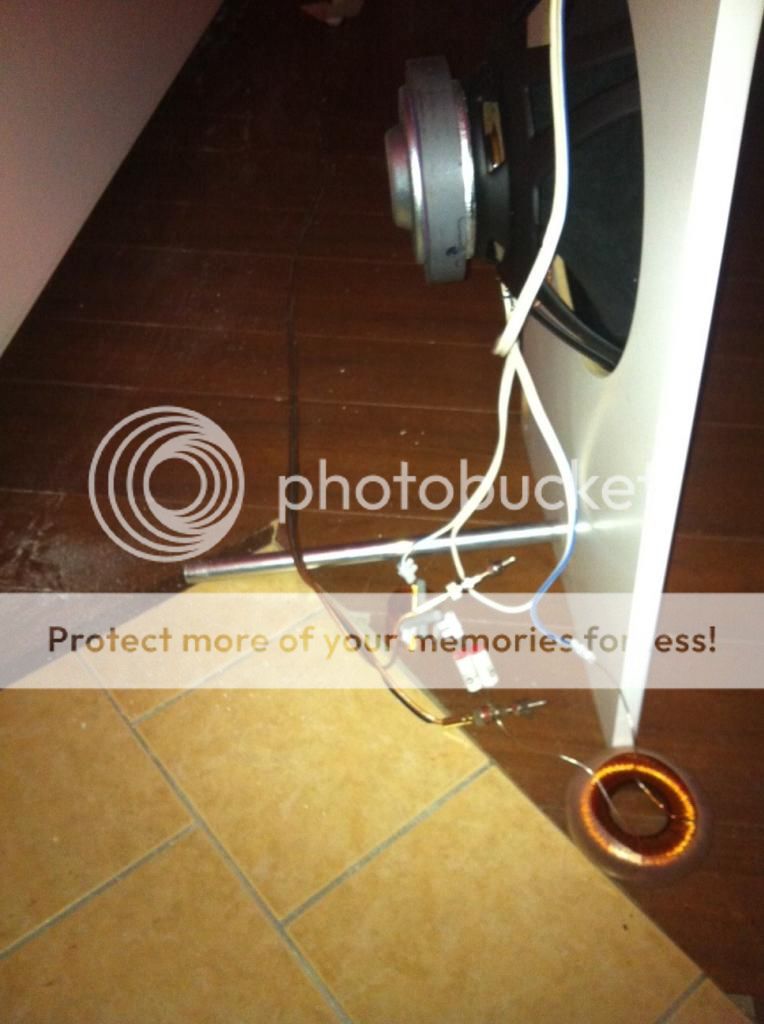
I know that I really should add the side panels, but just couldn't resist the temptation to hook them up...
AMAZING!!!! The sound is incredible! Despite being only hooked up to a 15 watts tube amp, they produce the sound with so much ease! Completely relaxed, me being able to listen to them for hours... Most interestingly, some songs I never really found interesting now sometimes bring something totally new and I can listen to them over and over again, without getting bored.
Even without the side plates, bass response already is quite amazing. Then again, in the first pictures, you might just see the Onken with MarkAudio Alpair 7 gen1, which is my reference.
There´s more to come regarding the design, once I´ve found the correct shapes for the side panels. Also, the one single alloy bar for the rear support will be changed in design on a lathe.
Bottom line, I think is: The Manzanitta is a great design and with Ikea offering cheap, good looking panels, it's quite easy to make great sounding speakers!
I know the Manzanita's were never intended as floorstanders, but I'm stubborn... The pieces of wood were higher than needed, so I figured it should compensate for some of the influence by the floor etc. Next to that, the Vifa's were a little too low for ear level, so I inclined the panels a bit.
I only just have the proto's finished, but already I'm so heavily impressed that I just wanted to share it with you all!
First some pictures (bit crappy, taken in the dark with my old Iphone):


I thought the filters might need to be tweaked quite some bit, so made a very temporary one:

I know that I really should add the side panels, but just couldn't resist the temptation to hook them up...
AMAZING!!!! The sound is incredible! Despite being only hooked up to a 15 watts tube amp, they produce the sound with so much ease! Completely relaxed, me being able to listen to them for hours... Most interestingly, some songs I never really found interesting now sometimes bring something totally new and I can listen to them over and over again, without getting bored.
Even without the side plates, bass response already is quite amazing. Then again, in the first pictures, you might just see the Onken with MarkAudio Alpair 7 gen1, which is my reference.
There´s more to come regarding the design, once I´ve found the correct shapes for the side panels. Also, the one single alloy bar for the rear support will be changed in design on a lathe.
Bottom line, I think is: The Manzanitta is a great design and with Ikea offering cheap, good looking panels, it's quite easy to make great sounding speakers!
Barry - looking good! They turned out nice. 
Bart-Jan. Fun idea on the Ikea panels. I've hunted around Ikeas, too - but did not see those. Are they solid?

Bart-Jan. Fun idea on the Ikea panels. I've hunted around Ikeas, too - but did not see those. Are they solid?
Bart-Jan. Fun idea on the Ikea panels. I've hunted around Ikeas, too - but did not see those. Are they solid?
You can normaly only see these panels in the kitchens of Ikea;-) Never as seperate parts. In the warehouse, they are seperate. They´re quite heavy 18 mm solid MDF and available in a selection of colors. Bright red, green, white and grey I believe. But not fully sure. They come with a plastic protection sheet on them, which is handy for using the tools for the cutouts of the drivers.
Tank You
Mr Busch and Mr Pano thank you for your kindness and sharing your design
one day fiddling with the minidsp and the manzanittas sound like heaven
my baffles has a tilt off 5 degrees, top end will be the same
chipamp/ marants pm80 mk2 ( usb-dac preamp soon )
yours Bart
Mr Busch and Mr Pano thank you for your kindness and sharing your design
one day fiddling with the minidsp and the manzanittas sound like heaven
my baffles has a tilt off 5 degrees, top end will be the same
chipamp/ marants pm80 mk2 ( usb-dac preamp soon )
yours Bart
Attachments
Very nice Bart.  Glad you are enjoying them. It's a simple but great sounding design.
Glad you are enjoying them. It's a simple but great sounding design.
I like the legs you made, they look good.
 Glad you are enjoying them. It's a simple but great sounding design.
Glad you are enjoying them. It's a simple but great sounding design.I like the legs you made, they look good.
After asking some questions on this forum and thinking about it for a long log time of building a pair of Amzanita's, I've finally bit the bullet! A trip to Ikea provided me some nice kitchen cabinet doors in the correct size😀.
I know the Manzanita's were never intended as floorstanders, but I'm stubborn... The pieces of wood were higher than needed, so I figured it should compensate for some of the influence by the floor etc. Next to that, the Vifa's were a little too low for ear level, so I inclined the panels a bit.
I only just have the proto's finished, but already I'm so heavily impressed that I just wanted to share it with you all!
First some pictures (bit crappy, taken in the dark with my old Iphone):


I thought the filters might need to be tweaked quite some bit, so made a very temporary one:

I know that I really should add the side panels, but just couldn't resist the temptation to hook them up...
AMAZING!!!! The sound is incredible! Despite being only hooked up to a 15 watts tube amp, they produce the sound with so much ease! Completely relaxed, me being able to listen to them for hours... Most interestingly, some songs I never really found interesting now sometimes bring something totally new and I can listen to them over and over again, without getting bored.
Even without the side plates, bass response already is quite amazing. Then again, in the first pictures, you might just see the Onken with MarkAudio Alpair 7 gen1, which is my reference.
There´s more to come regarding the design, once I´ve found the correct shapes for the side panels. Also, the one single alloy bar for the rear support will be changed in design on a lathe.
Bottom line, I think is: The Manzanitta is a great design and with Ikea offering cheap, good looking panels, it's quite easy to make great sounding speakers!
tweeters are to go on the inside congrats
What do you mean by this? On the backside of the baffle??? That's not what i understood from the original design. Opening up the back to let them 'breathe', yes, but not mounting them from there. Anyway, if they were, I'm extremely happy with the way they are now; It's like REAL music to my ears! These speakers amaze me every day, over and over again... They are THAT good!!
L speaker is to have the tweeter to the R of the woofer
R speaker is to have the tweeter to the L of the woofer
R speaker is to have the tweeter to the L of the woofer
Different question: currently I'm using a 15W EL84 tube amp. The sound is great, but a little underpowered... I'm thinking about building an amp with one of these: DIY Chip Amplifier Kits, PCB's, Components and Information. Now I've read that Gainclone's are not so forgiving for driving 'difficult' speakers. Do people have experience with the Manzinata and Gainclone amp?
I don't. I've driven them with either P-P EL34 tubes or Class-D amps (Tripath or Icepower).
There is a massive inductor in series with the woofer. The valve and Class-D amps handle this well, I don't know about the Gainclone.
There is a massive inductor in series with the woofer. The valve and Class-D amps handle this well, I don't know about the Gainclone.
I have used a Gainclone (LM3886, but the LM4780 is just a double LM3886) to drive them without experiencing problems. For years I have used a stereo Gainclone as power amplifier in my preferred test set up, and they've never acted up in any way.
However, I have not done very serious listening tests with that combination so I can't vouch for the sonic performance of the Gainclone-Manzanita combination, but my Linkwitz Orion are power by 8 LM3886 amplifiers and that combo sounds fine.
However, I have not done very serious listening tests with that combination so I can't vouch for the sonic performance of the Gainclone-Manzanita combination, but my Linkwitz Orion are power by 8 LM3886 amplifiers and that combo sounds fine.
John Bush mentions two interesting points somewhere in this long thread: Acoustically the crossover is effectively 2nd order, and in another place he says that reversing the phase of the Vifa results in subtle changes in the perceived response.
For a long time I was dissatisfied with what I felt was a huge “hammock” between 200 Hz and 2kHz . In actual fact I spent quite a lot of time trying to get rid of it to no avail – until I reread a large part of the thread and saw the two comments summarized above. I also did some measurements.
The first chart is smoothed 1/1 – and the “hammock” is quite visible – and so is the lack of it after the phase reversal. This does not point to “subtle” changes, though – rather the contrary. But the other chart showing the same measurements smoothed 1/3 octave could very well be interpreted as showing subtle changes. However, the sound of the phase reversed speaker is much more pleasing to my ears – in my room. And it seems that the cross over slopes are indeed 2nd order. And that usually calls for phase reversal of one of the units if the aim is flat summation.
A note on the measurements: They were taken in my room some 1.2 metres from one speaker placed in the centre of the room. The garbage at the frequency extremes is due to the measurement equipment. Also note that I was only interested in the cross over region – the differences in the high frequency response may be due to slight changes in the set up. (It was way too cold to do it outside!)
And now we are at it: During these test I have drives the speakers with an Almarro 318b - no problem! But the best combination seems to be the venerable old Quad 303!
For a long time I was dissatisfied with what I felt was a huge “hammock” between 200 Hz and 2kHz . In actual fact I spent quite a lot of time trying to get rid of it to no avail – until I reread a large part of the thread and saw the two comments summarized above. I also did some measurements.
The first chart is smoothed 1/1 – and the “hammock” is quite visible – and so is the lack of it after the phase reversal. This does not point to “subtle” changes, though – rather the contrary. But the other chart showing the same measurements smoothed 1/3 octave could very well be interpreted as showing subtle changes. However, the sound of the phase reversed speaker is much more pleasing to my ears – in my room. And it seems that the cross over slopes are indeed 2nd order. And that usually calls for phase reversal of one of the units if the aim is flat summation.
A note on the measurements: They were taken in my room some 1.2 metres from one speaker placed in the centre of the room. The garbage at the frequency extremes is due to the measurement equipment. Also note that I was only interested in the cross over region – the differences in the high frequency response may be due to slight changes in the set up. (It was way too cold to do it outside!)
And now we are at it: During these test I have drives the speakers with an Almarro 318b - no problem! But the best combination seems to be the venerable old Quad 303!
Attachments
- Home
- Loudspeakers
- Multi-Way
- Fast, fun, Inexpensive OB project
